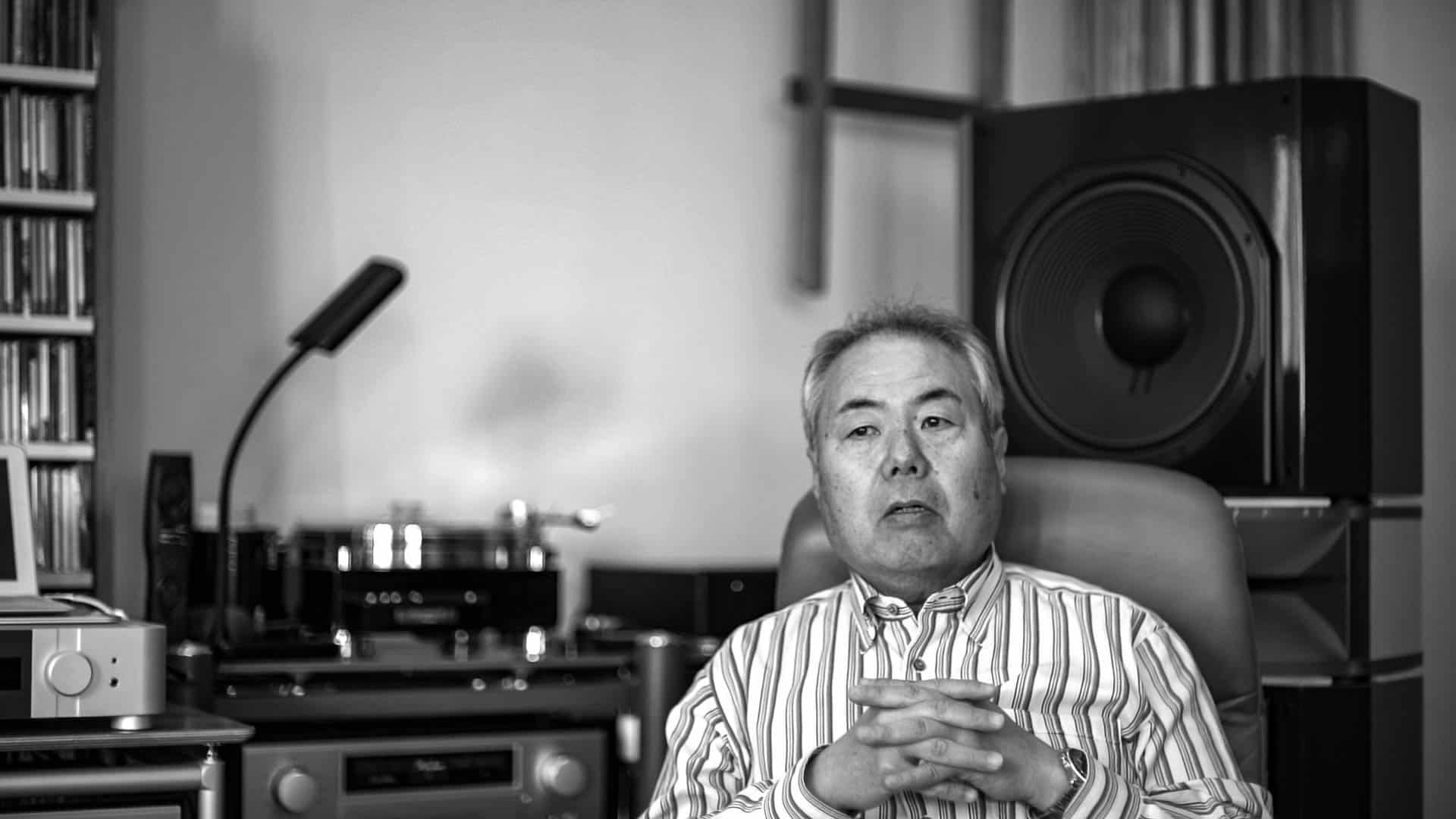
This past December we met with legendary Japanese audio magazine editor Kenji Mayuzumi, with a career spanning over 45 years Mr Mayuzumi has incredible knowledge of audio and still conserve tremendous passion for sound : that you will see along this interview, a special moment indeed to meet such an audio legend.
Could You Please Introduce Yourself To Our Readers?
I’m Kenji-Mayuzumi, I work as an Audio System Commentator in Japan, it’s just what people call me ! I’m actually just an Audiophile, just someone who loves audio ! Just before I turned 20 years old I joined a magazine called Stereo Sound as an editor and worked there for about 30 years, then about 15 years ago, I went freelance at 50 years old ! From then on I’ve been writing reports about various audio devices for other publications too.
Tell Us More About Your Loudspeakers And The Story Behind Them Please !
The system I use now, and you can see it behind me. It’s a JBL system, although they came out in 1989, these speakers were astonishingly good. I got hold of them 2 years later, at the end of ’91. The system was very expensive when it came out : at the time, I was still… How old was I in 1989? I think I was in my mid-40s : I couldn’t afford to buy them !
However, once I heard the sound, I just couldn’t resist the urge and after 2 years of thinking about them, I took out a big loan and got hold of them, I’ve been using them ever since. When I put together this JBL audio system, I wanted to make sure the speaker sounded good but for me the biggest single influence on making this speaker sound good has been using the Trinnov ST2 Processor !
Please Tell Us More About Your Room And The Acoustic Challenges You Faced Here
You can probably see part of this “room tuning” behind me. It’s owned by Nihon Engineering, It’s known as “AGS, Acoustic Grove System”. You can no doubt hear as we are doing this interview in here that my voice sounds very natural : when a room has strange acoustics, it affects your voice. For example, this is the first time you’ll have heard my voice, you might not have noticed, but if you try projecting your voice, there are no strange acoustics. You should notice the resonance feels very natural. Also, the ceiling is sloping, this exerts a big influence, the lower end of the ceiling is 2.4 meters high.
If you take this room’s surface area and its air volume than its floor surface area is 1.5 times greater, this space is extraordinary, compared to an apartment living room, it has a much more natural echo. Even so, there were still areas that I wasn’t happy with so, I added various “room tuning” equipment.
That improved the room’s acoustics tremendously; It made them very natural, there’s often a problem with the low frequency standing waves. Usually around 100Hz : that’s the bass frequency, that range starts to sound very unnatural and unclear. Such faults in the acoustics will distort the sound from the speakers.
So For You The Acoustics Of A Listening Room Should Be The Priority?
How should I put it? If the room’s acoustics are poor, you can’t hear the speaker’s original sound. The room’s poor acoustics will badly affect the speaker’s audio. This problem often occurs in an average living or listening room. The building was constructed 45 years ago. So it’s quite old.
By the way, a crack appeared in that wall since the Great East Japan Earthquake. That’s what we’re dealing with here! In old buildings, we lose the sound in various places; on the other hand, new apartment buildings are completely sealed spaces. That’s why those low-frequency waves seriously affect speaker sound.
You have your conventional audio components such as amps, CD players. Everyone has probably thought of how to get the best sound by combining them. I’ve prioritized creating a guaranteed advanced acoustics space.
It’s not massive compared to others, but compared to your average apartment, it’s blessed with much better acoustics. So I’ve used this space to my advantage listening to audio. If it’s not a good room, the end result is you can’t hear good sounds.
Have You Witnessed It In Other Listening Spaces?
When I was an editor for Stereo Sound, an audio commentator proposed asking readers which equipment they used and what music they listened to in their rooms. We wanted it to be a regular feature in the magazine, so we launched a page called “Audio File Interview” in Stereo Sound.
I did it for about 10 years and visited approximately 200 people’s homes and listening rooms. I asked them what kind of space they had, what equipment they used, what music they listened to…the experience I had doing these interviews left a great impression on me : what I learned from them is that the listening space is everything !
You must have a good room for listening to good audio. You can have good equipment or fantastic speakers but if your room acoustics are poor, it’s all for nothing. Those 200 people I interviewed used natural materials to create a fantastic acoustics environment.
Take, for example, a typical apartment. It uses synthetic building materials, even the wood used isn’t natural, they use various plywood attached like sheets of paper to make walls, like wallpaper. Often of such poor quality that they sound hollow when struck : pretty places like that don’t have good acoustics.
The room is vitally important in judging the sound quality of audio equipment; this is what my 40 years experience of working in this industry has taught me ! In that regard, this room is a relatively natural space, but I still felt it needed improvement.
That’s why I installed the AGS system acoustic treatment : compared to how it was before, the speaker sound has improved dramatically, the biggest improvement was the low-frequency waves. After that… for example, the bass interval is obvious : there are actually many rooms where you can’t hear the interval change. This room is better because I revamped its acoustics first.
So, Could You Tell Us What’s Different Between Trinnov And Other Products With Similar Functions, Such As The Optimizer?
The ceiling in this room is high compared to other studios. It’s like a shed roof which slopes low on one side. Therefore, it’s got great spatial dimensions. It has a relatively natural echo. I installed an “Acoustic Grove System” to improve the acoustics. This system has made the room’s “echo” sound very natural. The speaker sound is much clearer especially the low-frequency effects. I can now make out the finer acoustic effects.
However, although I’ve improved the acoustics… I felt more improvements could still be made, so I changed to Trinnov and tried to correct the system even more.
I’m not sure how to describe it. Furthermore, I kept the LCR network and adjusted it to the Trinnov speaker system. My earlier change to the room’s acoustics affected the sound wave harmonics. So, I think Trinnov has made life easy, there were few difficulties, and it kept things relatively simple, so now the acoustics quality has changed a lot.
For me, I’ve been able to realize this acoustic environment due to having the Trinnov processor. I never thought I could achieve this ! First I borrowed the Trinnov processor from Stella Inc, I tested it in, and right away was astonished by the change in the sound of the JBL speakers.

What Has Been Your Experience With Trinnov’s Unique Measurement And Correction System?
Trinnov uses this Tetrahedron measurement probe with four capsules that pick up the acoustic environment very accurately indeed. I think that’s brilliant. Up until now, processor systems used only one mic to pick up the sound. I would listen to the sound while adjusting the acoustics.
But the microphone-adjusted acoustics never matched exactly to what I had heard. I couldn’t get it close to the real sound with the single-mic system. However, Trinnov has been ground-breaking in that regard their measurement probe has changed things completely. It captures this room’s acoustics very accurately, so I can correct the sound even more precisely.
I mean, we haven’t had this up till now, take “time alignment”, for example; it’s when we correct the time gap between the driver and the woofer or correct the “frequency response” : with the Trinnov I’ve finally been able to do things like that and for me, it’s a bit like learning to walk! Things like “phase delay”, “group delay” and “impulse response” It’s able to detect many things.
This helps me correct the sound to its optimum level and I don’t think I’ve ever had such functionality before, I never had such high-level functions in one piece of equipment. Until now, I was restricted in which parts I could correct, so for me, in my line of work, this is critical, without using the Trinnov ST2 I wouldn’t be able to correct all aspects of the sound, for me, that is Trinnov’s main appeal.
There Must Be People Who Already Use A Very High-end System For Audio With Very Expensive Components: Would You Recommend Buying A Trinnov Processor To Them?
When I first listened to the sound coming from my speakers to be honest, I couldn’t believe how good it was. How could it have that capacity? I’ve been using those speakers for nearly 30 years, so it’s a real old-fashioned speaker with a very narrow range, for me, who’s been using it for nearly 30 years. It’s very dear to me as a lifelong companion, since installing my Trinnov processor, they sound so good I hardly recognize them anymore!
It doesn’t matter how great a listening room you have the acoustics will never be completely foolproof, so, the better your equipment the more you should use a Trinnov! That’s what I’d say to people that love sound.
I work in audio production, I have my listening room, I have all kinds of equipment – amps, CD players, cartridge players you name it! It’s my job to listen to audio and If I don’t listen to the original sound, I can’t make the right judgment, that’s why I use only Trinnov when correcting audio. Due to that, I feel more able to hear the genuine sound.
I think there are some people in Japan who’ve created fabulous studios with their first ever equipment, I’d love to introduce those people to the merits of using Trinnov, but it’s not just for people with superbly equipped studios, even people with average-level equipment, people who listen to music in a normal room, I think them too should install a Trinnov before buying any expensive amplifiers or speakers.
If they do that, then the overall sound will be incredible, and they’ll be closer to the music they want, they’ll have a direct connection to the original sound of the music, they won’t know the dynamic sound they’re missing unless they try to listen with a Trinnov on.
With Such High-end Equipment In Your Room : How Do You Compare The Sound Of The St2 Converters?
In my house, the setup includes that preamp from Accuphase which comes with analog output. So, for example, at midnight, I can’t play it loud late at night with all the houses around. I usually play it at this volume which may be slightly louder due to the noise outside – but it’s about right.
It’s wonderful that whatever the analog level coming in it doesn’t affect the Trinnov’s performance. The digital processing is carried out here converting from analog to digital and If the signal level is very low, the conversion will be extremely difficult.
Therefore, the conversion capacity of the ST2 HIFI are incredible, whatever the signal level, it performs the task properly, I think that’s wonderful. Also, Japanese audiophiles don’t have as much space to work in as Westerners, many people can’t play audio loudly : they want to play audio very quietly every night yet still be able to use the equipment properly.
I can’t imagine using anything other than Trinnov for that, so I want to ask the R&D team how they do it ?! I want to find out what’s going on inside, It has confounded all our ideas of what such audio equipment is capable of.
I feel like these Hi-fi components were made by aliens! Or made by people with a completely different way of thinking.
The culmination of these technological advances is to produce better effects and this relates to my earlier points, there are people who want to contribute and listen to great sound, but they don’t have the means to create a studio-like listening room, I’d recommend installing Trinnov even if all they have is a normal living room.

